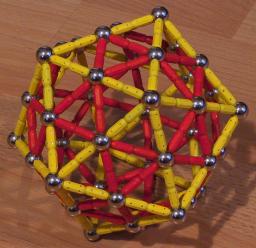Scaling Polyhedra
If you use one bar for each edge of a polyhedron, there are usually
two sizes you can create it in: short and long. If you want to make
your polyhedron larger, you have to use more than one bar per edge.
Here I'll discuss three approaches to this.
Connecting bars via spheres
The most obvious way is to use more than one bar per edge and to
connect the bars via spheres in a string. This creates the problem
that in addition to the faces not being stable, the edges themselves
are not stable anymore, so that, for example, a triangle, which
requires no stabilization if built with only one bar per edge, now
must be stabilized. In the case of triangles, this turns out to be
relatively easy, as this tetrahedron shows:
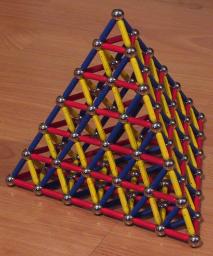
Fortunately, when stabilizing non-triagonal faces, the resultant polygons are in
most cases again triangles, and those can be stabilized easily, like
in this dodecahedron:
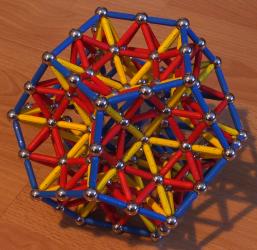
In some cases it's also possible to stabilize the polyhedron from
within, in addition to, or instead of, stabilizing the edges. This
is a cube with inner stabilization:
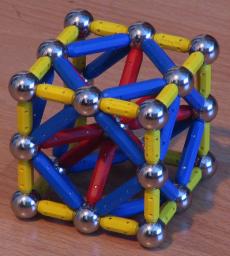
Note that without the inner stabilization, the cube would not be
stable. It is also possible to stabilize this cube by using short
4-stars for the edges, in addition to the blue long bars. Then,
the inner stabilization would not be necessary.
Connecting bars directly
You don't have to always connect bars via spheres. They can also
be connected directly, as this oversized tetrahedron shows:
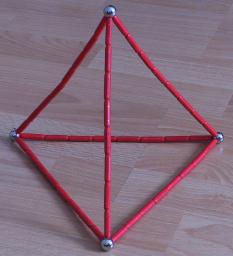
Note that when you use this approach, structures which use both
short and long bars may not scale up without some redesign, because
the ratio in length between a short bar and a long bar with spheres
attached is not the same as between two short bars and two long bars
with spheres. In other words: While you can build a right triangle
with a long bar, two short bars, and three spheres, you cannot do so
if you double the bars in length.
Using larger structures
One can also use more complex structures for edges. This is a
dodecahedron for which I have used a bridge-like structure instead
of a "thin" edge. Notice that a vertex is now no longer a single
sphere, but a triangle:
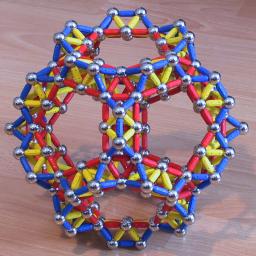
During the construction I had to support the pentagons with long
5-stars to keep the thing from falling apart. Even after I removed
the support when it was finished, it threatened to collapse under its
own weight. With the support, it was very stable, though.
Combining approaches
Of course, you can also use combinations of the approaches outlined
above. This, for example, is an icosahedron with each edge consisting
of two pairs of two short bars, connected by a sphere:
